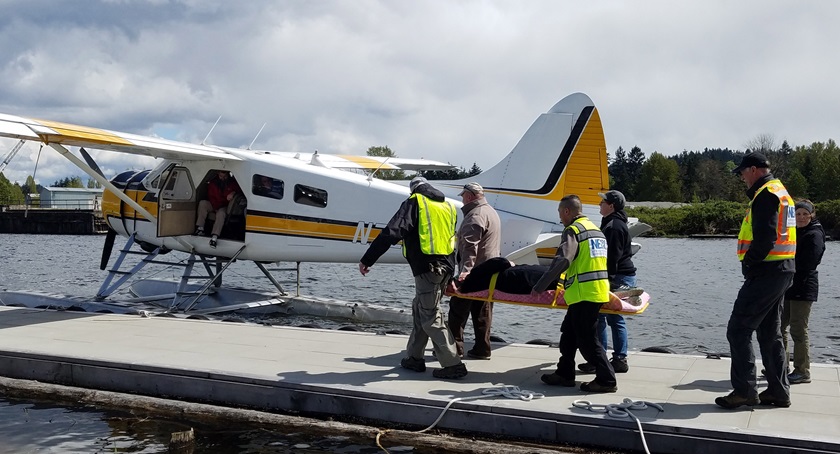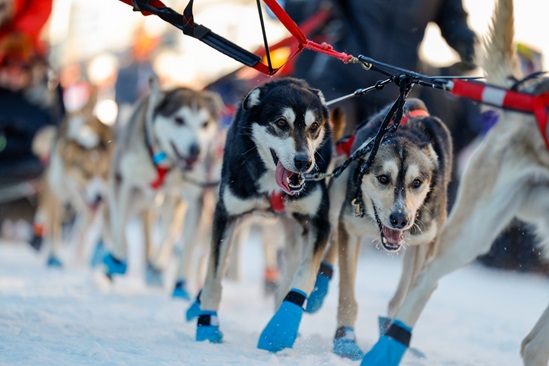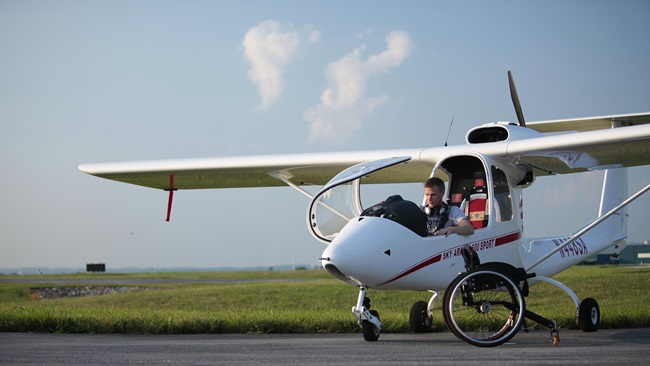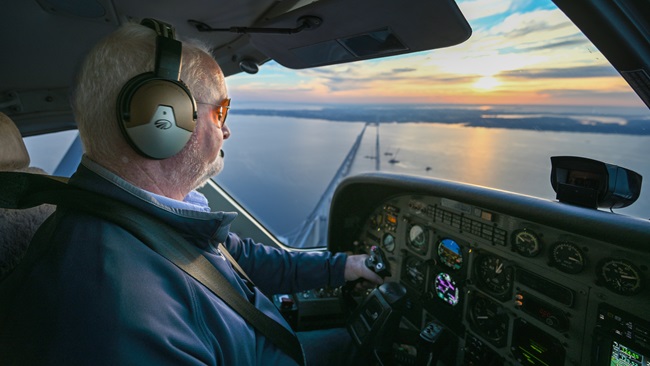Seattle quake exercise highlights general aviation
A live disaster drill in Washington state highlighted the versatile role of land-based aircraft and seaplanes in connecting the state’s inland airport hubs to coastal resources during a simulated multi-faceted post-earthquake relief effort.
Members of the Washington Pilots Association and Washington Seaplane Pilots Association teamed up with the No Town Left Behind emergency volunteer network to ferry 1,300 pounds of supplies—and one very accepting service dog—from Walla Walla Regional Airport to Renton Municipal Airport near Seattle during the first two segments of a three-leg land-and-sea airlift that began April 20.
Bonanza V35 pilot George Steed, president of the Washington Pilots Association, assisted during the Walla Walla supply relay and explained why other aviators pitched in. He told Seattle-Tacoma TV station Q13, “This is a way for private pilots to do what we are passionate about and to use that activity to help people if there is a time of need.”
Steed explained that the drills and exercises were designed to “test the system and uncover conflicts, weaknesses, and areas that need attention.” He said recruiting pilots and determining the “capabilities of GA to deliver supplies in an agile, efficient manner” was relatively easy compared to the challenges of “finding how we can best integrate with existing local, state, and federal emergency managers and organizations.” He added that 170 aviators pledged to help during a disaster and the pilot list was made available to established emergency management officials.
Cessna pilot Reilly Glore reiterated that pilots and their aircraft were valuable resources and could play key roles during an environmental disaster.
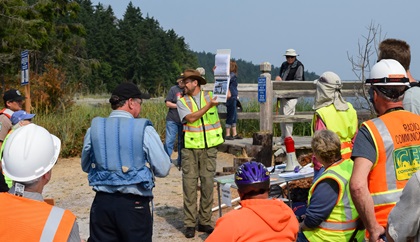
“If you want something to highlight general aviation, this is a great way to do it,” said Sky Terry, a disaster preparedness volunteer and a professional nurse who helped coordinate the test. He is the northwest regional emergency services director for the Emergency Volunteer Air Corps who coordinated and publicized the effort.
“We’re using seaplanes on the front half of the day to move supplies and resources into the area and during the back half of the day we’re using seaplanes to simulate transporting patients out,” he explained. “Basically, it’s an entirely new air logistics routing system with a very high possibility of being used during an actual earthquake,” he added. In addition to the Kenmore and Northwest seaplane specialists, other aviation relief organizations, pilot groups, and commercial operators participated in the flight coordination.
Earthquake relief drills formerly concentrated on either land-based aviation supply plans or water-based movements—but not both, said Terry.
He pointed to the success that the pilot-driven Operation Airdrop had after Hurricane Florence flooded the Carolinas in 2018. In that effort, more than 280,000 pounds of supplies were delivered by 475 GA flights. Similar success was reported after the grass roots group burst onto the scene in 2017 following hurricanes Harvey, Irma, and Maria, which devastated Texas, Florida, and the Caribbean.
Transporting a service dog was an unexpected treat but also a valuable learning tool, said Terry, who handled radio calls during the drill. “Inevitably you have people that have service animals, so you have to keep the animal with the people after a disaster.” A cheer went up from the seaplane dock crowded with volunteers after they gingerly lifted the black-and-tan animal and its crate into one of Kenmore’s de Havilland DHC–3 Otters. He complimented the estimated 60 to 70 people who participated on a chilly weekend morning during the final leg of the exercise.
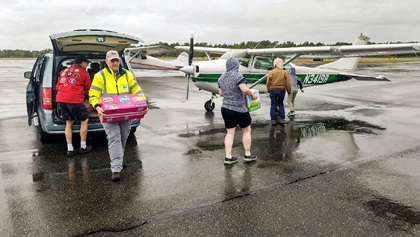
Terry and other Pacific Northwest emergency specialists are moving into high gear because experts have long predicted the region is overdue for a "megaquake." The potentially catastrophic natural disaster was defined by U.S. Geological Survey data and reported by KOMO News as a “magnitude 9 Cascadia quake” that could strike Seattle within “the next 50 years.”
Experts have predicted that the region is long overdue for what locals call “the big one.” In that scenario, violent shaking would last “approximately 100 seconds” and rattle downtown Seattle’s 18 buildings under construction that are “240 feet or taller.” Many of the city’s existing brick or stone buildings are “vulnerable to collapse” during a megaquake, the KOMO report added.
A 1964 earthquake in Alaska “obliterated” two coastal towns, Terry recalled. More recently, the West Coast shouldered the brunt of additional earthquakes that devastated large metro areas.
A 1989 San Francisco magnitude 6.9 quake was broadcast on national TV as the Giants battled the Oakland Athletics in the World Series. The earthquake crashed highway bridges, killed 63, and caused $6 billion in property damage. A few years later, a San Fernando Valley magnitude 6.7 earthquake near Los Angeles killed 57 and caused “staggering” damage, the encyclopedia Britannica noted.
The U.S. Geological Service website listed 34 magnitude 2.5 or greater U.S. earthquakes in a recent 24-hour period, from Tennessee through Alaska.
The results of a powerful tremor would devastate Puget Sound—a rich geological region bordered by tall mountains, deep lakes, a crisscross of rivers, and home to about 3.7 million Seattle-Tacoma-Bellevue residents. A 14-percent chance of such a natural disaster has unsettled Pacific Northwest business owners, residents, outdoor enthusiasts, and visitors. The sprawling metropolitan area is home to computer giant Microsoft, coffee powerhouse Starbucks, airline maker Boeing Co., several colleges, and a robust seafood industry.

The National Geographic reported that Seattle “could be devastated” by the next big quake along the Cascadia Subduction Zone because the populous city is “just 50 miles” from “one of the world’s most dangerous earthquake faults” that stretches into the Pacific Ocean from California’s Cape Mendocino to Canada’s Vancouver Island. The magazine noted that the last “major Cascadia quake” 317 years ago was “likely a magnitude 8 or 9” and unleashed a waterborne tsunami wave that “inundated the Pacific Northwest” that was felt as far away as Japan.
Terry predicted that GA aircraft and pilots would be crucial during the first 30 days following a major Seattle earthquake before sufficient federal efforts ramped up. “Here’s the math that really counts," he noted. "If you have 5,000 patients at an isolated hospital—and you don’t have a logistical means to supply that hospital—what do you think will happen to those patients? If you don’t use GA and the Disaster Airlift Response Team, then you have nothing. We’ll only have GA to keep people alive.”
“We’re there helping people that really need it,” volunteer pilot Ron Hockett told the Seattle television station. He emphasized that the group was “absolutely dedicated to helping others.”
